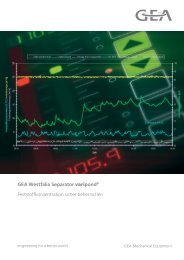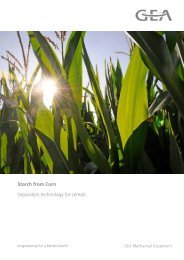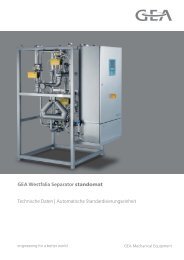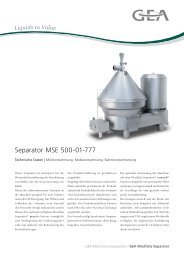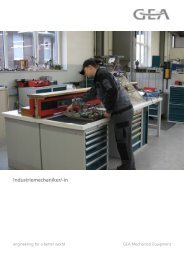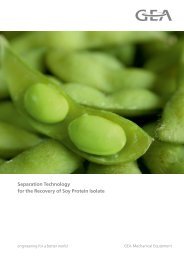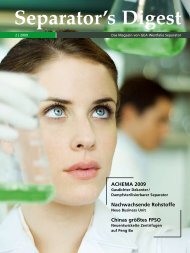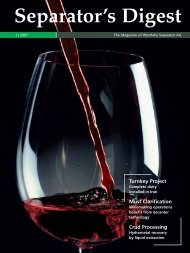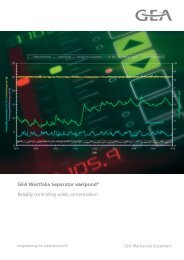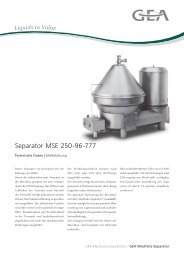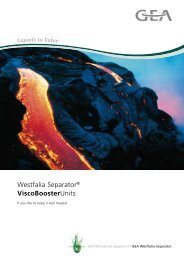Separator's Digest - GEA Westfalia Separator Group
Separator's Digest - GEA Westfalia Separator Group
Separator's Digest - GEA Westfalia Separator Group
Create successful ePaper yourself
Turn your PDF publications into a flip-book with our unique Google optimized e-Paper software.
Transparent production<br />
in the SchokoladeWerk, Zotter Schokoladen<br />
Manufaktur allows the numerous visitors to get<br />
to know all production stages of chocolate<br />
production in a type of glass production, from<br />
roasting and refining right through to conching,<br />
and also allows them to taste intermediate<br />
products such as cocoa nips and refining<br />
powder.<br />
The cocoa beans are first roasted. in the roasting<br />
process, the cocoa develops its typical aroma, and<br />
the beans are then treated to remove bacteria. in<br />
the crusher, the shells of the freshly roasted hot<br />
beans are removed, and the beans are broken<br />
down into small pieces, known as cocoa nibs. The<br />
nibs are conveyed to the cocoa mill, where they<br />
are broken down into their components. The<br />
cocoa butter is extracted, and melts as a result of<br />
the friction heat. This results in a liquid mass<br />
which looks very much like chocolate although it<br />
is not yet chocolate. The downstream ball mill<br />
improves the consistency of this cocoa mass even<br />
further.<br />
The decanter as a key<br />
component in the production<br />
chain<br />
The <strong>GEA</strong> <strong>Westfalia</strong> <strong>Separator</strong> CD 305 decanter<br />
operates as one of the new key components in<br />
the centre of the production chain. The most<br />
important step in the process of creating the taste<br />
of chocolate is that of conching. The cocoa mass<br />
requires appropriate consistency in order to be<br />
able to ensure an optimum conching process. The<br />
fat content as well as the grain size distribution<br />
are key aspects in this respect. As a result of the<br />
centrifugal separating properties of a decanter, it<br />
is possible to obtain a high-fat phase with very<br />
fine particles on the liquid side and a low-fat<br />
phase with coarser particles which is as solid as<br />
possible on the solids‘ side. The CD 305 decanter<br />
reduces the fat content from between 50 and<br />
56 percent to between 40 and 44 percent. The<br />
fat phase, the cocoa butter, can be recycled back<br />
into the process subsequently during conching.<br />
Due to the two-gear regulating facility patented by<br />
<strong>GEA</strong> <strong>Westfalia</strong> <strong>Separator</strong>, with variable bowl and<br />
differential speed as well as a torque regulating<br />
facility, Zotter has maximum flexibility with regard<br />
to the machine settings. This results in a very large<br />
number of possible recipes which previously were<br />
not possible in this form. in the past, for instance,<br />
the consistency of the cocoa mass had to be<br />
<strong>GEA</strong> <strong>Westfalia</strong> <strong>Separator</strong> Process<br />
27<br />
adjusted by adding sugar for binding fat; this<br />
generally had a limiting effect on the production<br />
of dark chocolate.<br />
This is followed by the mix. Enormous pressure<br />
in the refiner results in the ideal combination, the<br />
fine melt, and the aromas, until eventually only<br />
a trace of chocolate remains in the form of a<br />
fine powder. The refiner is a playing ground for<br />
creative persons and of course particularly for<br />
Josef Zotter.<br />
The decanter makes it possible<br />
The cocoa powder obtained is now processed in<br />
the conche. The chocolate in this way receives<br />
its final finish. The fine and dry powder is stirred<br />
for up to 20 hours in heatable conches. The fine<br />
aromas of the cocoa bean are completely released<br />
by these hours of treating the cocoa mass with<br />
various admixtures in very defined programme<br />
stages with precisely defined temperatures. The<br />
heat releases the aromas, any humidity and<br />
unwanted aroma constituents escape, and the<br />
cocoa butter liquefies again, thus permitting<br />
particularly fine distribution of the sugar and fat<br />
particles. The chocolate is finished.<br />
DECAnTEr CD 305<br />
Zotter was able to commence operation with<br />
the new production line in mid-2008: Dark<br />
chocolates with a very high cocoa content,<br />
for which demand is constantly increasing.<br />
The decanter makes it possible – and has also<br />
demonstrated this ability at other chocolate<br />
makers.<br />
<strong>Separator</strong>’s <strong>Digest</strong> 3 | 2008



